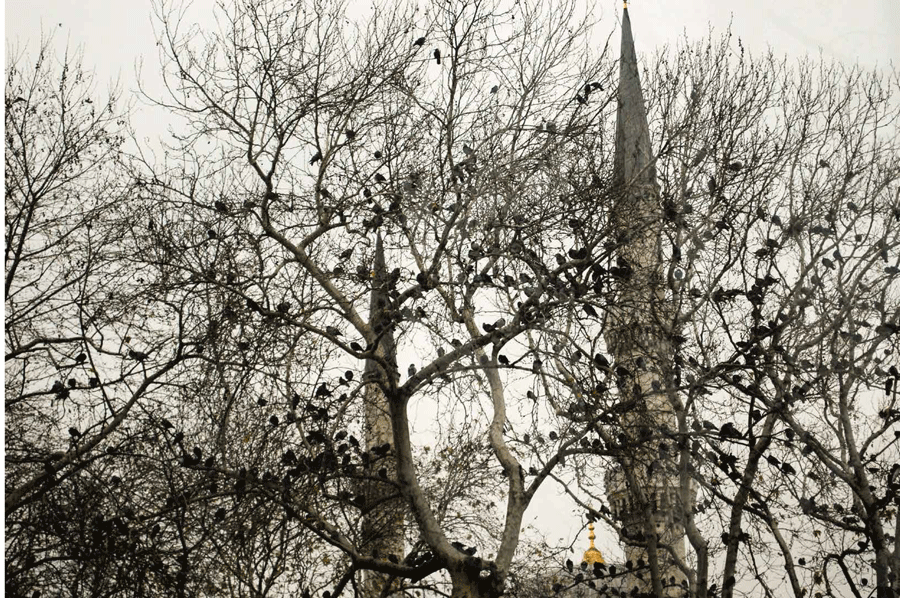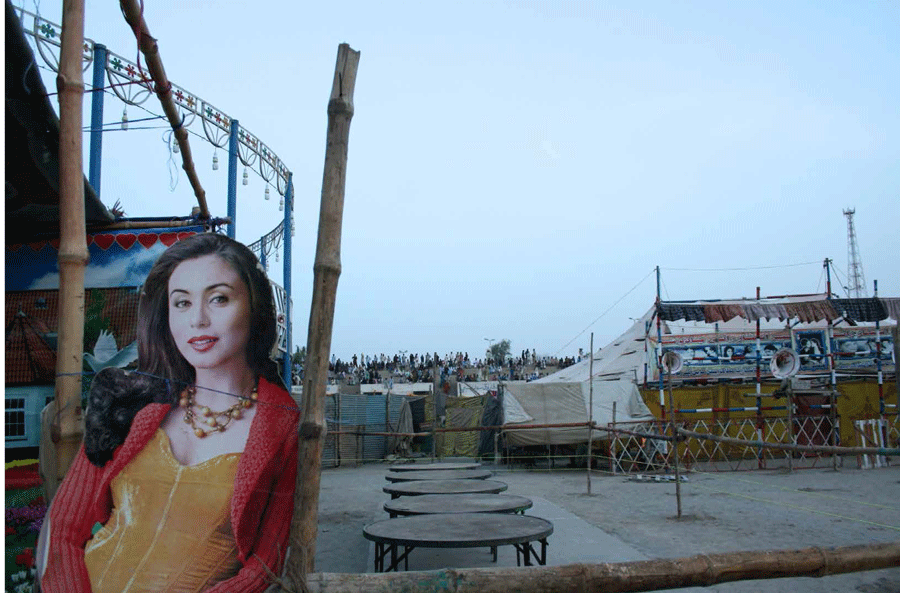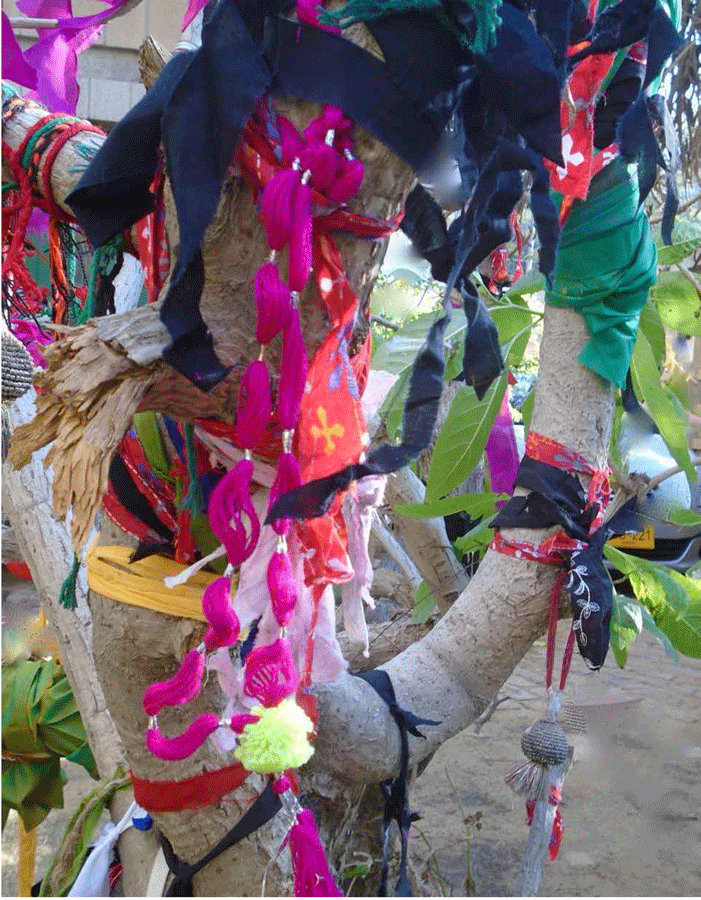Saints, Shrines and Ragged Hopes
By Nusrat Khawaja | Art Line | Published 6 years ago

Pilgrimage II: Nazia Akram.
There are places and practices that connect the human spirit with the idea of the eternal. Their existence is rooted in a yearning for what lies beyond the common pursuits of quotidian life. The mediation between despair and hope, between nature and the metaphysical, becomes an inextricable part of such places and practices.
The work of three artists showcasing such spaces was brought together at Koel Gallery, under the title Basera [abode]. Keeping in mind their interest in places associated with devotional practice, Noorjehan Bilgrami invited artists Nazia Akram, Omar Kasmani and Nabahat Lotia to a common platform. The outcome was an exhibition of extraordinary vitality and thematic consistency.
The exploration of sacred venues by the three artists has a profoundly immersive quality which testifies to their synergy with the spirit of the place. Their observations, expressed in their art, clearly reflects as a kind of journey undertaken by seekers. The impetus that draws them to the shrines is their intrinsic (al-batin) motivation. The expression of the motivation in the form of art is the evidence (al-zahir).
Nazia Akram travels to many sites of worship such as the shrines of Lal Shahbaz Qalandar in Sehwan, Shah Rukn-e-Alam in Multan and mosques in Marrakech and Andalusia. She photographs and video-records the worshippers, the architecture and the natural world in the form of trees and birds. Nazia then layers several images one upon the other to heighten the atmospheric quality she has sensed in each place. Her photographs have composite imagery but they offer a totality of experience as well as beautiful imagery.

Circus: Omar Kasmani.
‘Pilgrimage I’ and ‘Pilgrimage II’ look at monuments with the emphasis on natural elements. The birds in flight or perched on the fine filigree of branches are suggestive of a pantheism that indicates the universality of the divine. Nazia speaks of her work as devotional, an expression of her love for the Almighty. She says: “My work can be considered experimental, perhaps even unintentional, as I layer and intersperse what I see in my exterior environment alongside imagery of my own internal dialogue.”
Whereas Nazia’s photography reflects her thoughts and multiple journeys, Omar Kasmani’s photographs are all taken at Sehwan, which he visited many times between the years 2009 and 2018 as part of a research project. The series shown at Basera is called Coming Close/Going Far – a somewhat elliptical title for his research on “saintly intimacy.” His photographs include curious juxtapositions that create inflections of gentle irony, humour even, as they reveal the reality of saintly surroundings as a very human endeavour. Shahbaz Qalandar (who is conflated with the deity Jhule Lal) is strongly associated with the colour red. Appropriately enough, each image shown by Omar has a red object in it.
Omar’s camerawork is voyeuristic and inquisitive. ‘Shrine’ is a close-up showing the head and back of a man entering a dark chamber. His blue turban is set off against his red shirt. The frame of the door is also painted red. This person is literally entering a threshold. The image also contains implications of the crossing of the threshold between the mundane and the divine.
‘Circus’ is a remarkable study of enclosed and open space created by the paraphernalia of a gathering space. A row of tables, bamboo-fencing, loudspeakers and hoardings flank a courtyard. A cutout of a beautiful young woman in a red bolero jacket leans into the picture from the left corner. Above the horizon line in the distance, a crowd of men dot the hillside. The juxtapositions of objects and people is surreal and begs comparison between theatre and reality. When does the separation of the two transform into theatrical reality?
Resplendent in the front hall of Koel Gallery was an extraordinary tree. Dressed up with dozens of ragged strips in confetti colors, the pale bark of the tree showed off the explosion of colours to perfection. This sculptural eye-catcher was created from the trunk and branches of an actual Pisonia tree by Nabahat Lotia. The tree had collapsed in her garden and Nabahat reincarnated it in the form of a “munnat” tree.

Munnat: Nabahat Lotia.
The custom of tying rags and other objects to trees associated with sacred sites is common to many cultures across the world. Nabahat’s journey that led to the creation of ‘Munnat’ was made through the route of memory. Her father was a devotee of Data Ganj Buksh and he would take his daughter with him to Data Darbaar. Nabahat’s childhood observations of the rituals of shrine worship carved the ambience in her mind. She tapped into this reserve of memory to recreate the munnat tree. The variety of materials used in the installation and the diverse style of knots, give the impression of many hands having contributed to its creation.
There are manifold pathways to spirituality and artistic endeavour is a convincing portal to extraordinary abodes. When baseras are represented in art, interesting dialogues are generated regarding the nature of verisimilitude. The fine line between appearance and reality is subject to mediation by the artist.


